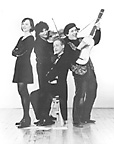Canada's Top Baroque Violinist Becomes Folk Hero As Fiddler by Wah Keung Chan and Tom Holzinger
/ December 1, 1999
Version française...
For David Greenberg, the secret to being a good crossover baroque
musician is having grown up in the folk tradition. "I have been playing folk
music since I was 5 years old," explains Greenberg. "Otherwise the
challenge of mastering the Cape Breton folk style would have been almost
insurmountable for someone like me, trained as a baroque musician. My
advantage was always trying to pick up all sorts of fiddle styles by ear.
You listen and you copy and you mimic."
Greenberg is speaking to La Scena Musicale by phone from his home in the
Toronto suburb of Missassauga, where he leads a dual life. He has a day job
as a top baroque and medieval violinist with the renowned Tafelmusik
consort. His other passion, early Celtic fiddle music, is lived out through a
crossover ensemble of his own making, Puirt a Baroque.
 Puirt a Baroque -- Gaelic for "tunes from the baroque" -- was formed by
Greenberg and his wife, musicologist and fiddle player Kate Dunlay, in
1994. Although the group is filled out by two established baroque
musicans, Terry McKenna on guitar and David Sandall on harpsichord, the
group's favourite genre is crossover music of the 18th century, a
combination of intellectual music and the local Scottish folk music of the
era. Later, when the Highlands were cleared, that music emigrated and
planted itself in Cape Breton, Nova Scotia, where it has been kept alive
and now thrives in the great Canadian fiddling renaissance. Puirt a Baroque -- Gaelic for "tunes from the baroque" -- was formed by
Greenberg and his wife, musicologist and fiddle player Kate Dunlay, in
1994. Although the group is filled out by two established baroque
musicans, Terry McKenna on guitar and David Sandall on harpsichord, the
group's favourite genre is crossover music of the 18th century, a
combination of intellectual music and the local Scottish folk music of the
era. Later, when the Highlands were cleared, that music emigrated and
planted itself in Cape Breton, Nova Scotia, where it has been kept alive
and now thrives in the great Canadian fiddling renaissance.
Why does Greenberg, raised in Maryland and trained in Indiana, love playing
this music? "Part of the fun is in the murkiness of the style," he says.
"Much of the tradition comes from players and composers of 18th-century
Scotland who specialized in both the folk and elite kinds of music making.
In their works you often find combinations of these two kinds of music.
What draws me is an affinity for that heartfelt expression in music. I
appreciate any musician who can communicate in that way."
Communication is clearly one of Greenberg's great passions. "When you
play a note, it has to be in context and convey something. It has to be felt
as well as played. The notes on the page are only aids." Does this hold true
in classical baroque music as well? "Well, even when I learn a baroque
piece I have to translate it into a feeling that is added to the performance.
In the early crossover music there is this sense of aliveness in the music.
Mostly I want to hear that aliveness, a connection between one note and
the next. Ideally there is this spontaneity each time," he says eagerly.
He should know. He has made over 40 classical recordings with Tafelmusik
and three widely acclaimed crossover disks with Puirt a Baroque,
including last year's Return of the Wanderer. He is renowned for his ability
on the vielle, or medieval fiddle. And he has recently recorded an album of
traditional Cape Breton music with that region's top artists, due out soon
on the Marquis Classics label.
I ask him if his fusion music is like jazz. He prefers to duck the term. "I do
not combine beautiful tone with spontaneous expression in Cape Breton
music. Depending on the moment, we alter our hierarchy of musical
esthetics. Playing these two different styles with two different
hierarchies, one reinvigorates and refreshes the other ... With Monteverdi
you have to rein yourself in. On the other hand the Gaelic style has
technique and virtuosity that open up new spectrums of colours and
feelings and ways of communicating that are so refreshing."
"It keeps you on your toes to always play with feeling and spontaneity and
quickness of spirit," he concludes. "That kind of aliveness has to be there
for any kind of music."
Version française... | 

